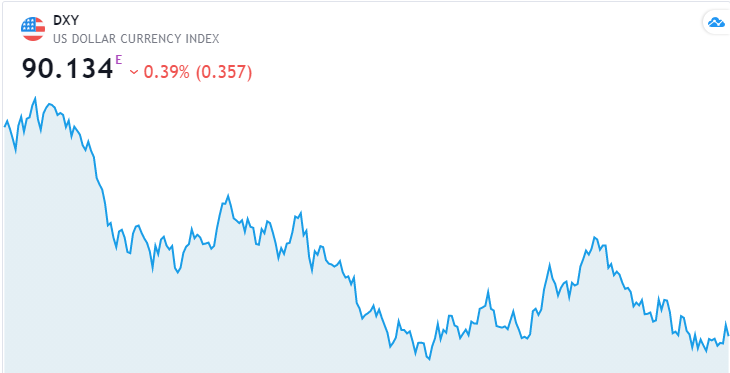
★
Summary
★
On Friday, the United States announced that non-farm payrolls rose by 559000 in May, up sharply from the previous figure of 262000 in April, but still slightly less than the market forecast of 650000, while data showed that the unemployment rate fell back to 5.8% than expected. As a result, the labor force participation rate fell further. Cooling expectations that the Fed will tighten monetary policy sooner rather than later. The dollar fell against Gmur10 across the board, while the Australian dollar rose 1.1% at one point, the biggest gain since April 14. European currencies fell collectively, with the euro down 0.21% and the pound 0.23%. The yen rose 0.3% against the trend. Commodity currencies fluctuated, with the New Zealand dollar falling 0.5% and the Canadian dollar falling 0.08%. At one point, the Australian dollar hit a six-year high, while the Australian dollar rose 0.35%.

After the release of non-farm data in May, the dollar fell rapidly, giving up most of the previous day's gains due to strong "small non-farm" data, sending the dollar index up just 0.09 per cent on a weekly basis. The dollar index fell 0.40% to 90.14, falling from a three-week high hit earlier in the day. At one point, the yield on the 10-year Treasury note fell 7 basis points to 1.56%, the biggest drop in a month. Driven by the accelerated vaccination of COVID-19, the number of non-farm payrolls in the United States increased by 559000 in May, but an increase of 675000 is widely expected.

Analysts at Imperial Commercial Bank of Canada pointed out that the overly generous unemployment benefit measures provided by the US government are still the main culprit in preventing the rapid growth of the employment population; however, at a time when the relevant measures are about to be terminated, job growth will accelerate after the beginning of the summer, and millions of new jobs are expected to continue to be created in the US market by the end of September. Edward Moya, a senior market analyst at OANDA, said the employment data was a bit disappointing. The weaker-than-expected report means that the Fed does not have the urgency to start slowing down its $120 billion-a-month bond purchases. Bad economic news is good news for the ultra-loose Fed, which will put the dollar in trouble. Despite the increase in jobs in may, non-farm payrolls are still 5%, or 7.6 million, below pre-crisis levels, National Bank Of Canada economist Jocelyn Paquet said in a client report. As a result, the labour market still has a long way to go.
Mestre, chairman of the Cleveland Fed, said Fed policy makers should "be patient" before considering scaling back their asset purchases after seeing more evidence of progress in the US labor market. "I think this is a sound employment report, but I hope to see further progress," she said. " Mestre notes that the labor force participation rate of young people has not yet returned to pre-epidemic levels. She says she is not overly worried about inflation because wage increases are not expected to be transmitted to overall prices.
Biden attributed the continued growth in U.S. employment to vaccination and the economic stimulus bill signed in March, deliberately downplaying the fact that job creation was lower than economists had expected. "this is historic progress that has pulled our economy out of the worst crisis in 100 years," Biden said from Rehobos Beach in Delaware. No other major economy in the world is growing as fast as we are. These successes are not accidental. It's not luck. "
This week (June 7-13), a number of countries will release big data, including the consumer price index ((CPI)) of the United States and China in May, the (GDP) of the United Kingdom in April, the first request of the United States and other data. As for the central bank, Fed officials entered a "period of silence" this week. The Bank of Canada and the European Central Bank will announce interest rate decisions in June. In addition, the IEA will also release its monthly crude oil market report.
Market focused this week
On Monday, China's May trade account, Switzerland's May unseasonally adjusted unemployment rate, Switzerland's May CPI, China's May foreign exchange reserves and the euro zone June Sentix investor confidence index.
On Tuesday, the monthly rate of industrial output after quarterly adjustment in Germany in April, the scale of social financing in China in May, the final quarterly rate of GDP in the first quarter of the euro zone, the ZEW economic climate index in June in the euro zone, the trade account of Canada in April and German Finance Minister Scholz spoke on the budget policy during the COVID-19 epidemic.
On Wednesday, China's May CPI, the Bank of Canada's June interest rate resolution, and the US EIA crude oil inventory report.
On Thursday, the European Central Bank decided on interest rates in June, the US core CPI annual rate in May was not adjusted quarterly, and the number of US jobless claims in the week ended June 5.
On Friday, the UK April industrial output, the UK April seasonally adjusted merchandise trade account, the UK April GDP monthly rate and the US June preliminary consumer confidence index of the University of Michigan, the Bundesbank released its semi-annual forecast and the IEA released its monthly crude oil market report.
Risk Warning: The above content is for reference only, and does not represent JRFX’s position. JRFX does not assume any form of loss caused by any trading carried out in accordance with this article. Please consult your financial planner for your investment portfolios and manage your own risk.
JRFX is an online CFD broker providing more than 50 products for Forex, metals and commodities. Open a trading account within a minute. Deposit 100USD and download our MT4 trading platform now!

|

|

|

|

Views: 112379

Likes: 0